The link of two Mexican Mints and one Die
by Juan Felipe Ramirez
Summary
This is the report of two coins of eight reales dated 1819, one from Durango and other from Chihuahua, whose obverses were struck with the same die.
Introduction
Cutting dies require a masterful condition in engraving. Each artist leaves an indelible legacy of his sculpture art skills in the coins. All mints have specific features and styles on their coins given by these craftsmen. That uniqueness was especially relevant during the period of the Mexican War for Independence, when the difficult conditions imposed by the conflict added a dramatic circumstance that derivates in the wonderful field of collecting and research we enjoy nowadays.
The roughness of the coins produced in the War for Independence mints contrast with the good manufacturing process and quality of the Mexico mint. Collectors learn very soon that these coins have important differences in the manufacture of planchets, dies and coining presses. Arguably the toughest part was to find a good engraver, so not surprisingly dies were used even when worn, broken or outdated.
The mints of Durango and Chihuahua have been linked by the resemblance of their coins’ portraits and the evidence of some eight reales of Durango struck over Chihuahua planchets and vice versa. Some, such as Pradeau Alberto Pradeau, Numismatic History of Mexico,1938, reprint 2001, page 85, assume they had the same engravers or even that the dies were made in the same place. But, what about being struck under the same roof? The finding of a pair of coins, one from Durango and one from Chihuahua, dated 1819/8 whose obverse were manufactured with the same die opens new and exciting possibilities.
Now let me mention another important topic. On many occasions what is seen as an overdate is just a correction made over a new die. Sometimes it is very difficult to observe due to the good job of the engraver, the softness of the strike, bad condition of the coin or all combined. The only way we can be certain that it is truly an overdate is to find a coin of the previous year that shows the same characteristics but a difference in the digit subject of the re work. Once you find this coin you can be certain that it is truly an overdate. That is what I call the “smoking gun”, the irrefutable proof that we are talking about the same die that has been updated.
Methods
To make this analysis we have direct observation of some specimens and pictures available on the web.
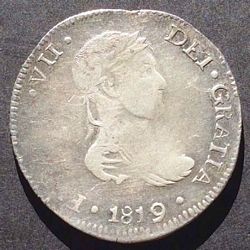
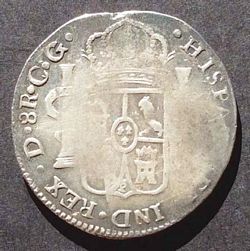
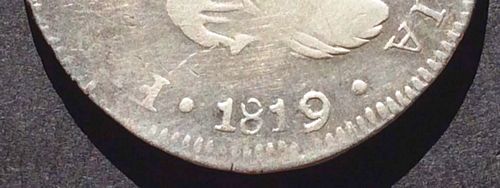
Description Specimen A.
Obverse: FERDIN . VII . DEI GRATIA . 1819/8 . Reverse: . HISPAN . ET IND . REX . D . 8R . C/R . G/M.
Not mentioned by Pradeau, CalicoXavier Calico, Numismática Española, 2008, or Krause Krause, Standard Catalog of World Coins of Spain, Portugal and New World, 2002.
On the obverse of this specimen we can see two features that attract the eye: the 9 in the date that clearly looks worked in a different scale and inside the number a faint remains of the 8 are observed as well. But the most important feature for this study is the die’s crack, a fine line that comes from the lower part of the bust to the base of the F of FERDIN. This damage becomes relevant because it gives an idea of the evolution of the damage therefore the timeline of the specimen’s manufacture.
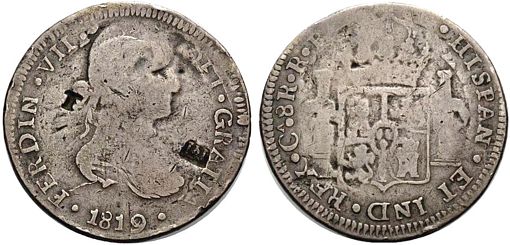

Description Specimen B.
Obverse: FERDIN . VII . DEI GRATIA . 1819/8 .
Reverse: . HISPAN . ET IND . REX . CA . 8R . R . P . (Ramon Peimbert)
Mentioned in Krause, not in Pradeau or Calico.
Chihuahua coins from 1815 to 1822 were struck over cast planchets of years 1810 to 1813. In this specimen we can see the same features mentioned above for specimen A but struck over a planchet of cast Chihuahua exhibiting the two punches, pomegranate between pillars and the T for treasury. The former punch style almost always corresponded to cast coins dated 1811. In the process of this research we have seen this die used also over the punched planchet with pomegranate type of 1812. All Chihuahua resulting coins were very uneven in strike, therefore it is very difficult to make accurate and meaningful comparison so that is why the crack in the die provides a unique opportunity to compare the coins.
Look how the crack of the die progresses telling that this coin was struck later than the Durango specimen.
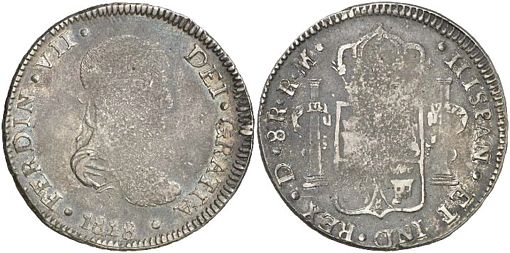

Description Specimen C. “The Smoking Gun”
Obverse: FERDIN . VII . DEI GRATIA . 1818 . Reverse: . HISPAN . ET IND . REX . D . 8R . R . M.
Now that we can be sure that the same die was used to strike both Durango and Chihuahua coins, let us look at the mother coin made in Durango with the same obverse die of the previous coins that should prove it is truly an overdate. In this case it is dated 1818 and carry the assayer RM in the reverse. That assayer, by the way, was the second assayer that year after the MZ and before the CG. The letters in the obverse die has been engraved directly by hand on the die rather than guided by the master punch. Notoriously, in the obverse the final eight of the date is larger and there is an incipient crack of the die running from the lower part of the bust to the base of the F of FERDIN. All other devices and features on the obverse are exact to the Chihuahua and Durango specimens as well.
Discussion
Despite the resemblance and similarities of the portraits of the coins of Durango and Chihuahua in the later years of the War for Independence period, only speculations about the relation of these two mints have been made. This analysis proves that they use the same die to strike both coins, so the link between them is clear. It is still unclear if they loaned the die or if the coins were struck in Durango. Any event is very unlikely that happened all the time. Other coins of year 1819 exist in Chihuahua with other dies, so the mint had more options. According to Occam’s Razor, if multiple explanations are suitable to clarify one event, the simplest will tell the truth. So, it is easy to carry a die from Durango to Chihuahua rather than to carry a load of silver planchets from Chihuahua to Durango, strike the coins and send them back again. In any case the event shown here looks a rare event. Other examples linking these or other mints could appear after more numismatic research.
Conclusion
As seen here there is an irrefutable proof that there was a close relation between the mints of Durango and Chihuahua and at least in one case we can be sure Durango manufactured at least one die used later in Chihuahua.
